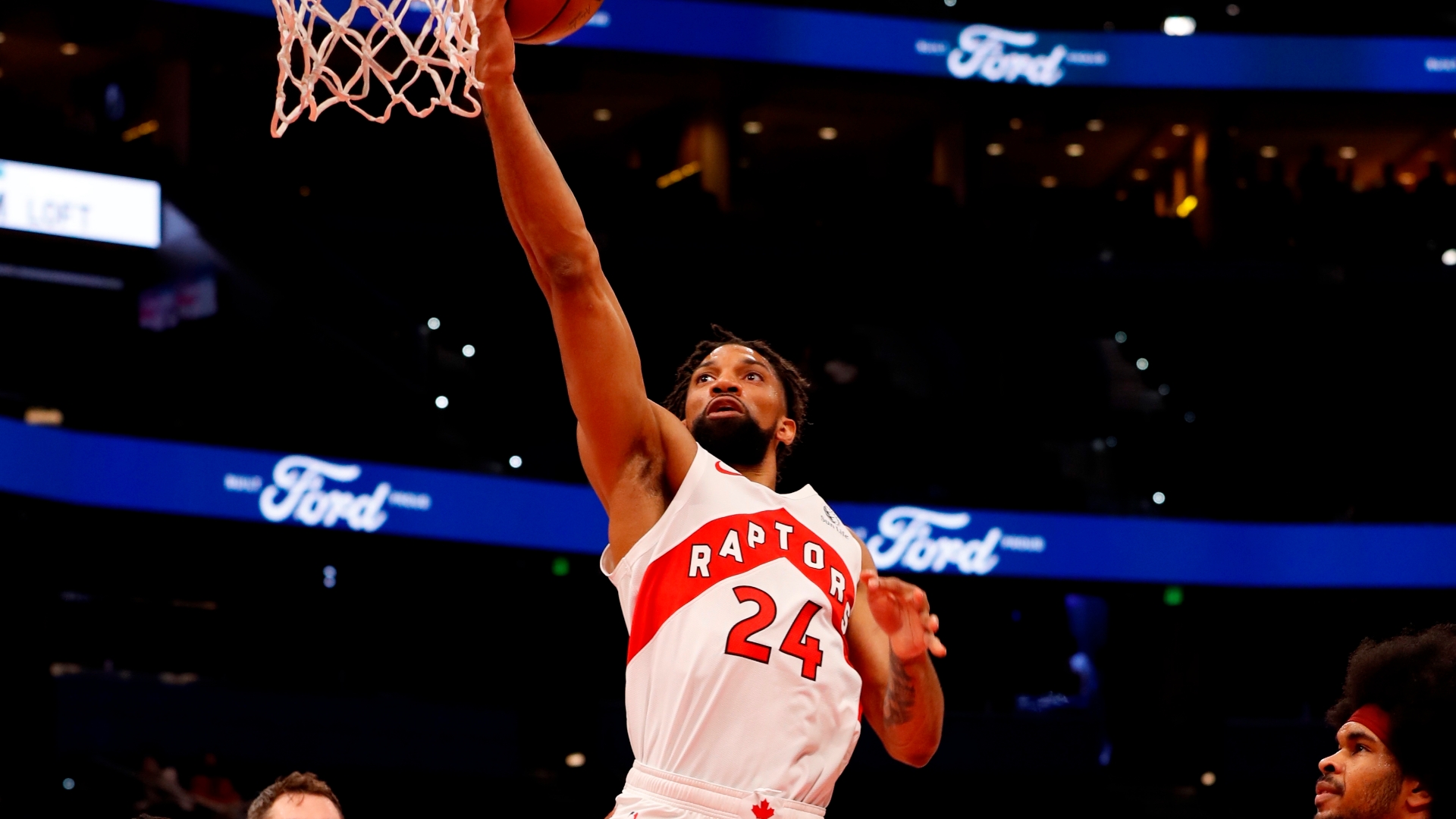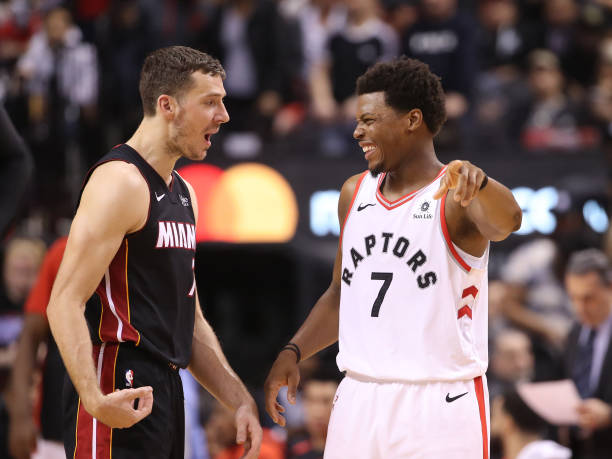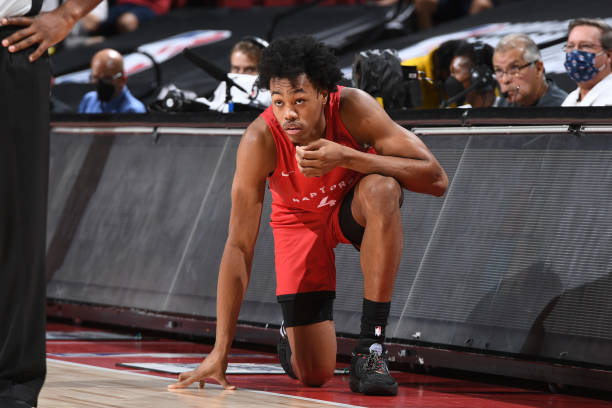If injury, homesickness, and virus were a three-headed external hydra that derailed the Toronto Raptors’ 2020-21 season, the woeful center position was a three-headed internal hydra that fought to achieve the same goal.
Toronto started the year with Aron Baynes, Alex Len, and Chris Boucher as centers. Not to reiterate their flaws, but none of the three was ready to sop up starting center minutes, and Toronto was pummeled on the glass, suffered a clogged offensive lane for drivers, and generally failed to play the defense that had become the norm for the past few seasons. Okay. To reiterate their flaws just a little bit.
Those self-inflicted wounds, in many ways, healed on April 13 when Khem Birch played his first game for the Raptors, scoring a modest 13 points in 25 minutes. The Raptors lost, sure, but they played a competitive game with the eventual Eastern Conference finalists Atlanta Hawks without Kyle Lowry or Fred VanVleet. Freddie Gillespie made his debut only a few days earlier. On one hand, the Raptors had a negative net rating the rest of the way, but they were above .500 for the rest of April before they shut down their key guys. More importantly, their starting lineup of Lowry, VanVleet, OG Anunoby, Pascal Siakam, and Birch had a ridiculous net rating of 22.3, albeit in only 92 minutes.
And now the Raptors have added the blue-chip prospect Precious Achiuwa to the roster in a sign-and-trade deal for Lowry. That gives Toronto three centers at six-foot-nine (or six-foot-eight) with ridiculous wingspans to make up for it. What will the center rotation hold for Toronto next year? Will it be another source of poor starts and blown leads? Or will Toronto return to the salad days of Marc Gasol and Serge Ibaka? (Likely, as with most things, somewhere in the middle). Here’s what to expect.
Khem Birch
Let’s start at the top. After signing a three-year, $20M deal with Toronto this offseason, Birch is the medium-term future at the center spot for Toronto. For stretches, he looked like he was having incredible impact with the team. His deeper on-off numbers sank somewhat towards the end of the season, but much of that was because he played many of his minutes alongside Gillespie and without a proper creator, meaning he was asked to create much of his offense for himself. That’s not where Birch is going to thrive. By the end of the year, he had earned the status of a solid, mid-career prospect. He spoke openly in Orlando about being allowed to stretch his game, and Nick Nurse and the Toronto staff offered him plenty of freedom to expand his skill-set and role.
On the offensive end, Birch is going to set an avalanche of screens. He makes solid contact, wearing down opposing point-of-attack defenders, and he rolls hard to the rim on almost every occasion. Though he was forced at times to pop and launch threes when sharing the court with Gillespie, his future is in rolling to the rim. He takes up space, forces opponents to react to him, and creates lanes for jittery guards.
At times, Birch will roll without a sense of timing. He can plow into drivers’ backs if they hesitate in the paint, which happened occasionally with VanVleet. But he has a good nose for angles, and he led Toronto in cuts per game in his few minutes. When he does get the ball on the roll, he has good hands and a surprisingly developed arsenal of push shots, floaters, and little hooks. He could stand to draw more fouls, with a shooting foul rate of just 10.8 percent when shooting as a roll man. Still, he shot 58 percent from short midrange and 68 percent at the rim with Toronto, both great marks, but the short midrange percentage was far above his numbers from Orlando. Some of that was surely due to his playing with better point guards than ever before, but he’ll need to show that those improvements can remain part of his game in the long-term.
Those skills even allow him to score on quick duck-in post ups. He’s not going to be a post hub, but he can get a few quick points every so often when teams disrespect him with a small, against a switch, in transition, or on the offensive glass.
He’s an excellent offensive rebounder. Birch also showed a solid passing game on the move that allowed him to catch the ball on the roll, draw defenders, and extend the advantage while toggling the ball across the court. He’s not an elite vertical finisher a la Achiuwa (more on that in a moment), so his ability to still create open shots for the Raptors when he’s not the one taking them is a huge plus. It’s nothing fancy, but it’s still valuable stuff.
Defensively, Birch was fantastic alongside Toronto’s best defenders and much less certain alongside Toronto’s lesser defenders. That’s not surprising. He’s not going to lift a bunch of average defenders into the stratosphere, like a Joel Embiid type, but he’s a great fit alongside defenders who can hold their own. Birch was fantastic at guarding the pick and roll, recovering to the paint, cleaning the glass, and forcing turnovers. The Raptors can play a league-leading defense with Birch manning the center spot. He’s not the most important defender — VanVleet, Anunoby, and Siakam all have varying claims to that title, with all three having All-Defense abilities — but he’s not going to let the lineup down like Toronto’s starters last year. Even though Birch isn’t an individual rebounding savant, his teams have generally been better at holding opponents to fewer offensive rebounds with him on the floor, with Birch’s best mark coming last year with Toronto as he set a 99th-percentile rate as an on-off defensive rebounder.
There are some benchmark skills that could determine Birch’s future impact with the Raptors. If he becomes a solid catch-and-shoot shooter, that would be an important development for opening driving lanes for Siakam and VanVleet. If he can tighten his handle and body control, he’ll be able to create more attempts for himself at the rim and draw more fouls there. If he can guard in isolation, he would help Toronto’s wing defenders force even more turnovers as they rotate behind him. (He’s already fairly good at that, but there’s always room for improvement.) Birch is never going to be an All Star. But with him on the floor, Toronto could massively outscore opponents if everything goes right. That’s a huge jump from last year.
Precious Achiuwa
Introducing Toronto’s keynote acquisition to help lessen the sting of the Kyle Lowry departure: Precious Achiuwa. Those are unfair expectations to place on a sophomore center, but that’s the rub.
Achiuwa sure has potential. At the moment, he’s not going to be a hugely positive player on the court for Toronto. That’s very normal for young centers. But he’s a physical marvel, which seems to be a quality upon which Toronto is trying to corner the market (cough, Scottie Barnes, cough). The dude’s got bounce.
Like, BOUNCE.
Unfortunately, Achiuwa screens like a man who knows he’s got bounce. He rarely follows through and makes contact, generally slipping screens so as to reach the rim sooner. That often results in pick and rolls that don’t go anywhere, which is why his 1.14 points per possession as a roll man were more or less the same as Birch’s 1.09. He’s a great finisher in the air, but he doesn’t do enough to set up his cuts, thus meaning he minimizes the time he actually spends in the air. If he were to slow down, create contact, allow his guards to create an advantage, and then thunder to the rim, he would find even more opportunities to thunder on opponents.
To that point, Achiuwa doesn’t have a wonderful sense of timing or angles. He makes up for that with an incredible motor, always staying on the move, running with purpose, and constantly trying to add to possessions. Those are good qualities. Adding in a Birch-ian sense of timing to crash through windows when they’re open would make him the deadliest off-ball mover Toronto has had at the center position for a long time.
Achiuwa has little touch around the rim when it’s not a dunk, and his post game is entirely based on facing up and then passing the ball.
He does, however, draw a carnivalesque number of fouls, largely because he can spend so much time in the stratosphere above the rim.
Defensively, Achiuwa has a similarly high ceiling and low floor. Like all young bigs, his ability to read plays is generally limited to what’s going on in the present, rather than anticipating the future. The Heat were worse defensively with him on the floor last year (which makes sense, considering he was backing up Bam Adebayo), but they were a poor team when Achiuwa was playing, with a net rating of negative-7.2. They rebounded only 70.8 percent of defensive rebounds with Achiuwa playing, lowest on the team with his minutes played or more. Their offense was similarly worse with him.
Achiuwa has a huge amount of talent, and he does many impressive things on the court. He hasn’t been able to translate that to winning. That’s normal for bigs of his age, but don’t expect him to usurp the starting position from Birch or contribute massively to a resurgent year. Achiuwa is a project for the Raptors. He has an incredible ceiling, but he’ll need to developing basically every area to reach it. Keep a long-term focus with him.
Freddie Gillespie
As long as we’re talking long-term focuses, Freddie Gillespie is the longest-term project at the center position on Toronto’s roster. He’s raw and untested, but he has nascent skills that could allow him to grow into a winning player. Without going too far into detail, his impact numbers weren’t wonderful last year.
Offensively, Gillespie sets good contact as a screener, and he has some touch on shots on the move. His most polished shot attempt may be a push shot on the move, reminiscent of Birch.
But his static attempts need development, as he doesn’t have a jumper or many moves around the rim, either. To become an offensive positive, Gillespie needs to become a quicker decision-maker and a significantly better finisher. At times, Gillespie put his athleticism on show with moves that were far above his normal skill level. Such bursts of power and grace were startling; a man who can do this against a switch is one with near-limitless potential.
Defensively, Gillespie actually boasted the highest block rate among the three centers, and he showed an absolute fearlessness to challenge anyone around the rim. He has a good sense of timing on his blocks, and his length means he can challenge anyone even when he’s late. Gillespie actually had solid rim protection ability outside of blocks, holding opponents to 8.3 percent lower accuracy than expected from within six feet. That was a better mark than those set by Achiuwa (negative-6.3) or Birch (negative-2.0).
Otherwise, Gillespie could use some extra seasoning. He’s not particularly mobile despite being undersized for a big, and he can find himself out of position sometimes for rebounds. But as with Achiuwa, that’s completely to be expected. He’s an advanced rim protector for his experience level, and that’s more than could already be asked. He has plenty to learn on both ends, particularly on offense, but he has time to learn it. Bigs take time. Don’t expect to see Gillespie play regular minutes for the big club, but if he is called up for spot minutes, you know what you’re going to get. That’s huge for a third-string center, and it’s something that Toronto couldn’t even say of its starting centers for much of last season.
Conclusion
Eventually, Achiuwa likely has the highest ceiling of the three. He’s 21 years old, and he is the most physically gifted of the three. That’s saying something, as Birch is an athletic freak, and Gillespie’s wingspan is actually the longest of the three. (All have comically long wingspans above seven-foot-one.) Achiuwa projects to be a rim-runner like Tyson Chandler in his heyday, and that’s always a valuable archetype in the NBA.
But at the moment, Birch will be the most valuable center on the roster. He’s by far the most capable defender, and he’s the smartest and most polished offensive player, as well. At his best, he could become a Richaun Holmes type, who is a fantastic play finisher and defender and can stretch the floor vertically and through little flip shots. Expect Birch to start and play the most minutes. The others are projects, so Birch should see the important minutes, too.
At the same time, Toronto has a variety of other players who can play center in a pinch. Boucher was forced out of position to play center last year, as he’s best as a power forward. But Toronto can boost its offense with Boucher at the five for stretches. Similarly, Anunoby, Siakam, or even Barnes could play some center to maximize shooting, ball-handling, switchability, and turnover creation. Even if Birch is Toronto’s long-term center this season, he may not close some games at the position. That’s normal. Toronto has seven players who could feasibly see center minutes this upcoming season. Beyond the skills, the solidity, the consistency: having so many bodies available is already the biggest change for the Raptors, and it’s one that Nurse will gladly take coming into the year.



